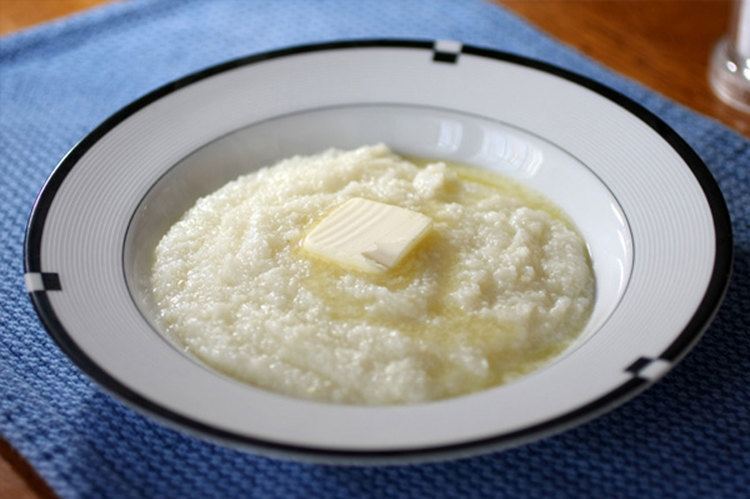Type Porridge | Main ingredients Ground corn | |
 | ||
Variations Hominy gritsYellow speckled gritsCheese grits Similar Shrimp and grits, Hominy, Cornbread, Cornmeal, Gumbo | ||
Shrimp scampi and creamy parmesan grits
Grits are a food made from corn that is ground into a coarse meal and then boiled. Hominy grits are a type of grits made from hominy with the germ removed, which is corn that has been treated with an alkali in a process called nixtamalization. Grits are usually served with other flavorings as a breakfast dish, usually savory. Grits were traditionally popular in the Southern United States but now are available nationwide. They may also be found as an evening entrée when made with shrimp. Grits should not be confused with boiled ground corn maize which makes "hasty pudding" or "mush" or when using coarse ground corn, which may be made into polenta, or the "mush" made from more finely ground corn meal.
Contents
- Shrimp scampi and creamy parmesan grits
- Shrimp and grits recipe full of southern goodness how to make
- Origins
- Preparation
- Grits dishes
- References
Grits are of Native American origin and are similar to other thick maize-based porridges from around the world such as polenta.

The word "grits" is an uncountable noun, cf. "mashed potatoes." It derives from the Old English word "grytt," meaning coarse meal.

Shrimp and grits recipe full of southern goodness how to make
Origins

Grits have their origin in Native American corn preparation. Traditionally, the hominy for grits was ground on a stone mill. The ground hominy is then passed through screens, the finer sifted material used as grit meal, and the coarser as grits. Many American communities used a gristmill until the mid-twentieth century, farmers bringing their corn to be ground, and the miller keeping a portion as his fee. State law in South Carolina requires grits and rice meal to be enriched, similar to the requirement for flour, unless the grits were made from the corn which a miller kept as his fee.
Three-quarters of grits sold in the U.S. are bought in the South, in an area stretching from Texas to Virginia that is sometimes called the "grits belt". The state of Georgia declared grits to be its official prepared food in 2002. Similar bills have been introduced in South Carolina, with one declaring:
Whereas, throughout its history, the South has 'relished its grits', making them 'a symbol of its diet, its customs, its humor, and its hospitality'; and whereas, every community in the State of South Carolina was once the site of a grits mill and every local economy in the State used to be dependent on its products; and whereas, grits has been a part of the life of every South Carolinian of whatever race, background, gender, and income; and whereas, grits could very well play a vital role in the future of not only this State, but also the world, if, as The Charleston News and Courier proclaimed in 1952: 'An inexpensive, simple, and thoroughly digestible food, [grits] should be made popular throughout the world. Given enough of it, the inhabitants of planet Earth would have nothing to fight about. A man full of [grits] is a man of peace'. Now, therefore, be it enacted by the General Assembly of the State of South Carolina: Section 1. The 1976 Code is amended by adding: 'Section 1-1-703. The official state food is grits.'
In the South Carolina Lowcountry, the uncooked ground rice is known as "grist", and the cooked dish is "hominy". This is distinct from the usual use of the term hominy.
Grits are either yellow or white, depending on the color of corn. The most common version in supermarkets is "quick" grits, which have the germ and hull removed. Whole kernel grits are sometimes called "speckled".
Preparation
Whole kernel grits are prepared by adding five or six parts boiling water (seasoned with salt—1/4 tsp for each cup of water) to one part grits and cooking for 20 to 45 minutes. Grits expand when cooked and need periodic stirring to prevent sticking, and lumps from forming. They are not done until they have absorbed four and one quarter times their volume of water. The additional water allows for some evaporation as they cook. Whole grain grits require much longer to become soft than do "quick grits." Grits are most typically served seasoned salt and pepper, as well as generous amounts of butter. On occasion they are served with grated cheese, sausage, bacon, or red-eye gravy. Grits may also be seasoned with butter and sugar, and a small amount of salt, giving them a salty-sweet flavor similar to kettle rice.
Extra, i.e. left-over, grits can be put into a glass tumbler, chilled until needed, sliced, and fried either plain or with a breading. In this form they are denominated "fried grits," "fried hominy," or "grit cakes."
Grits dishes
Grits are eaten with a wide variety of foods, such as eggs and bacon, fried catfish, salmon croquettes, country ham, and many other dishes.
Shrimp and grits is a traditional dish in the Low Country of coastal South Carolina and Georgia. A variation of the dish is also consumed for breakfast in the northern states of Kedah and Perlis in peninsular Malaysia. It is a traditional breakfast dish.
"Charleston-style grits" are boiled in milk instead of water, giving them a creamy consistency.
Solidified cooked grits can be sliced and fried directly in vegetable oil, butter, or bacon grease, or they can first be breaded in beaten egg and bread crumbs.
